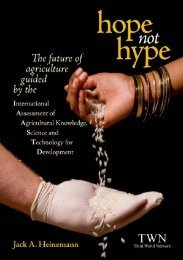The Avon Lady comes collecting Asian medicinal plants
The Avon Lady comes collecting Asian medicinal plants
The Avon Lady comes collecting Asian medicinal plants
You also want an ePaper? Increase the reach of your titles
YUMPU automatically turns print PDFs into web optimized ePapers that Google loves.
and in effect claim use of that plant as an ingredientin any product that improves “the aestheticappearance of aging skin”.Most of the 16 <strong>plants</strong> <strong>Avon</strong> claims are familiar foodand <strong>medicinal</strong> <strong>plants</strong> in different <strong>Asian</strong> countries,including the following examples:Bignay: In patent application WO2012005876,<strong>Avon</strong> claims use of four different <strong>Asian</strong> <strong>plants</strong>used in skin care products that stimulate productionof a skin protein called MAGP-1. Amongthem is the bignay (Antidesma bunius), a fruit treegrown across Asia. Also called “mao luang” or“currant tree”, the bignay’s striking strands ofmulticoloured fruit are a popular food in Indonesia,while in the Philippines and Thailand, the fruitis both eaten and made into a wine. Bignay is veryfrequently cited among inventories of <strong>medicinal</strong><strong>plants</strong> of diverse cultures across the region.Elephant foot yam: In US patent 7,618,662, <strong>Avon</strong>claims use of six different <strong>Asian</strong> <strong>plants</strong> in productsthat stimulate fat production by the skin (whichis said to improve appearance). Among the <strong>plants</strong>claimed is Amorphophallus campanulatus, an aroidknown in English as the elephant foot yam. Grownfor its edible tuber, the elephant foot yam planthas a pungent odour and many documentedtraditional <strong>medicinal</strong> uses, including to treat skindisorders. 4Agati: Also claimed in US patent 7,618,662 isSesbania grandiflora, or agati (sometimes “agathi”).Frequently grown in Southeast Asia and India, theplant’s leaves are used for food and, in Thailand,its flowers used in soups. It is also used in bothAyurvedic medicine and traditional medicine inSoutheast Asia, including for skin problems.Bai yanang: <strong>Avon</strong> claims use of Tiliacora triandrain skin care products in patent applicationWO2012002950. With no English common name,the plant is usually called bai yanang, or simplyyanang, its name in Laos and Thailand. Bai yanangis closely associated with the foods of Laos andthe Isan culture of Thailand, where the leaves ofthis commonly cultivated plant are used in soups.In Vietnam, the plant is used to create a popularjelly.False daisy: In patent application WO2011156136,<strong>Avon</strong> claims Eclipta prostrata, known as false daisy,as a cellulite treatment. False daisy is a native ofthe Americas that is widely distributed around theworld. It can be considered <strong>Asian</strong>, however, becauseits <strong>medicinal</strong> use has mainly been developedthere. In China, its use for many health problemswas advised in the manual for that country’s famous“barefoot doctors”, 5 while it also appears inaccounts of Indian traditional medicine, includinguse to treat skin problems. 6Alisma orientale: <strong>Avon</strong> has obtained exclusiverights to another Chinese plant in US patent7,410,658, which claims use of Alisma orientale totreat skin problems. Known as dong fang ze xie,the plant grows on the margin of lakes and pondsin a large part of China and in some surroundingcountries.Bình vôi: In US patent 7,514,092, the companyclaims skin treatments using any of three <strong>Asian</strong><strong>plants</strong>, including Stephania rotunda, an unusualplant cultivated in Vietnam. <strong>The</strong>re it is called bìnhvôi, meaning “lime pot”. <strong>The</strong> name refers to theshape of the plant’s unusual tuber, which is mostlyabove the soil, and which resembles the shape ofceramic pots used to hold lime (for betel nut chewing).English sources sometimes give the plant’sname as “saboo leard”.Soap nut: Also claimed in US patent 7,514,092 isSapindus rarak. This species is one of several thatare sometimes called “soap nut” in English. S. rarakis particularly well known in Indonesia, whereit is called lerak. As its English name implies, theplant’s seeds produce soapy compounds and, inIndonesia, lerak is favoured for use in washingtraditional batik fabrics. Like many other <strong>plants</strong>claimed by <strong>Avon</strong>, lerak is well known in Asiafor traditional <strong>medicinal</strong> uses, including on theskin.<strong>The</strong> Fountain of Youth: <strong>Asian</strong><strong>medicinal</strong> <strong>plants</strong> in <strong>Avon</strong> products<strong>The</strong> ingredients of <strong>Avon</strong> products were reviewedto determine how the <strong>plants</strong> that the companyclaims are being used. To date, five of the <strong>plants</strong>claimed in the patents and patent applicationscan be found in <strong>Avon</strong>’s skin care products: falsedaisy (Eclipta prostrata), elephant foot yam (Amorphophalluscampanulatus), agati (Sesbania grandiflora),Pouzolzia pentandra 7 and soap nut (Sapindusrarak). Because each plant is used in several itemswithin an <strong>Avon</strong> skin care product line, the five<strong>plants</strong> can collectively be found in more than 24<strong>Avon</strong> products.Like a modern commercial version of the Fountainof Youth legend, all of the four product linesthat contain the <strong>Asian</strong> plant extracts consist ofitems that claim to make the skin of users ap-4
















